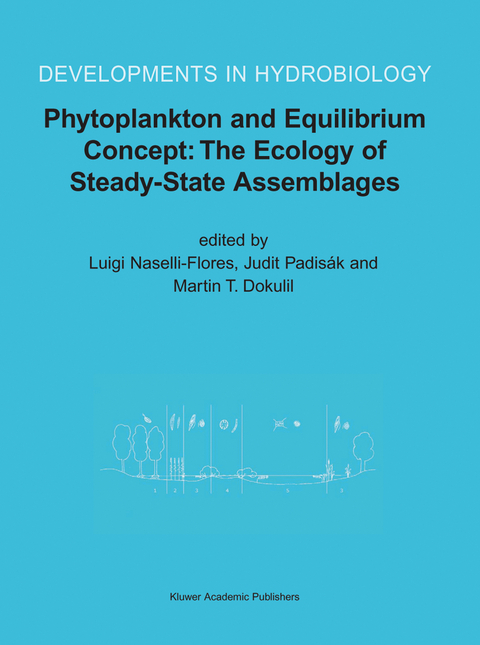
Phytoplankton and Equilibrium Concept: The Ecology of Steady-State Assemblages
Springer-Verlag New York Inc.
978-1-4020-1647-9 (ISBN)
From IAAP to IAP.- Are there steady-state phytoplankton assemblages in the field?.- Life strategies, dominance patterns and mechanisms promoting species coexistence in phytoplankton communities along complex environmental gradients.- Phytoplankton assemblage at equilibrium in large and deep subalpine lakes: a case study from Lago Maggiore (N. Italy).- Steady state phytoplankton in a deep pre-alpine lake: species and pigments of epilimnetic versus metalimnetic assemblages.- Steady state phytoplankton assemblages during thermal stratification in deep alpine lakes. Do they occur?.- The Effect of perturbations on phytoplankton assemblages in a deep reservoir (Vouglans, France).- Factors influencing the phytoplankton steady state assemblages in a drinking-water reservoir (Ömerli reservoir, Istanbul).- Steady-state assemblages of phytoplankton in four temperate lakes (NE U.S.A.).- Phytoplankton assemblages and steady state in deep and shallow eutrophic lakes — an approach to differentiate the habitat properties of Oscillatoriales.- Equilibrium phase conditions in shallow German lakes: How Cyanoprokaryota species establish a steady state phase in late summer.- Steady-state assemblages in a Mediterranean hypertrophic reservoir. The role of Microcystis ecomorphological variability in maintaining an apparent equilibrium.- Algal assemblage types of bog-lakes in Hungary and their relation to water chemistry, hydrological conditions and habitat diversity.- Dominant species, functional assemblages and frequency of equilibrium phases in late summer phytoplankton assemblages in Hungarian small shallow lakes.- Steady-state phytoplankton assemblages in shallow Bulgarian wetlands.- Controlling factors of phytoplankton assemblages in wetlands: an experimental approach.- Steady state ofphytoplankton assemblage in the tropical Lake Catemaco (Mexico).- Do steady state assemblages occur in shallow lentic environments from wetlands?.- The role of physical stability on the establishment of steady states in the phytoplankton community of two Maritime Antarctic lakes.- A companion to the identification of cryptomonad flagellates (Cryptophyceae = Cryptomonadea).- Taxonomic notes on some freshwater planktonic Cryptophyceae based on light microscopy.- Ecological and taxonomic observations on the flagellate algae characterising four years of enclosure experiments in Lake Tovel (Southern Alps).- How diverse are planktonic cryptomonads in Brazil? Advantages and difficulties of a taxonomic-biogeographical approach.- Occurrence of Cryptophyceae and katablepharids in boreal lakes.- Dominance patterns of planktonic algae in Swedish forest lakes.- Distribution and seasonal dynamics of Cryptomonads in Sicilian water bodies.- Flagellate algae (Chrysophyceae, Dinophyceae, Cryptophyceae) in 48 high mountain lakes of the Northern and Southern slope of the Eastern Alps: biodiversity, taxa distribution and their driving variables.- Redefinition of Peridinium lomnickii Wo?oszynska (Dinophyta) by scanning electronmicroscopical survey.- Long-term trends in species composition and diurnal migration of dinoflagellates in Lake Tovel (Trentino, Italy).- Planktic oscillatorialean cyanoprokaryotes (short review according to combined phenotype and molecular aspects).- A new planktic species of Pseudanabaena (Cyanoprokaryota, Oscillatoriales) from North American large lakes.- Estimation of minimum sedimentary inoculum (akinete) pool of Cylindrospermopsis raciborskii: a morphology and life-cycle based method.- Equilibrium/steady-state concept in phytoplankton ecology.
| Erscheint lt. Verlag | 31.12.2003 |
|---|---|
| Reihe/Serie | Developments in Hydrobiology ; 172 |
| Zusatzinfo | XI, 403 p. |
| Verlagsort | New York, NY |
| Sprache | englisch |
| Maße | 210 x 318 mm |
| Themenwelt | Naturwissenschaften ► Biologie ► Botanik |
| Naturwissenschaften ► Biologie ► Evolution | |
| Naturwissenschaften ► Biologie ► Ökologie / Naturschutz | |
| ISBN-10 | 1-4020-1647-6 / 1402016476 |
| ISBN-13 | 978-1-4020-1647-9 / 9781402016479 |
| Zustand | Neuware |
| Haben Sie eine Frage zum Produkt? |
aus dem Bereich


